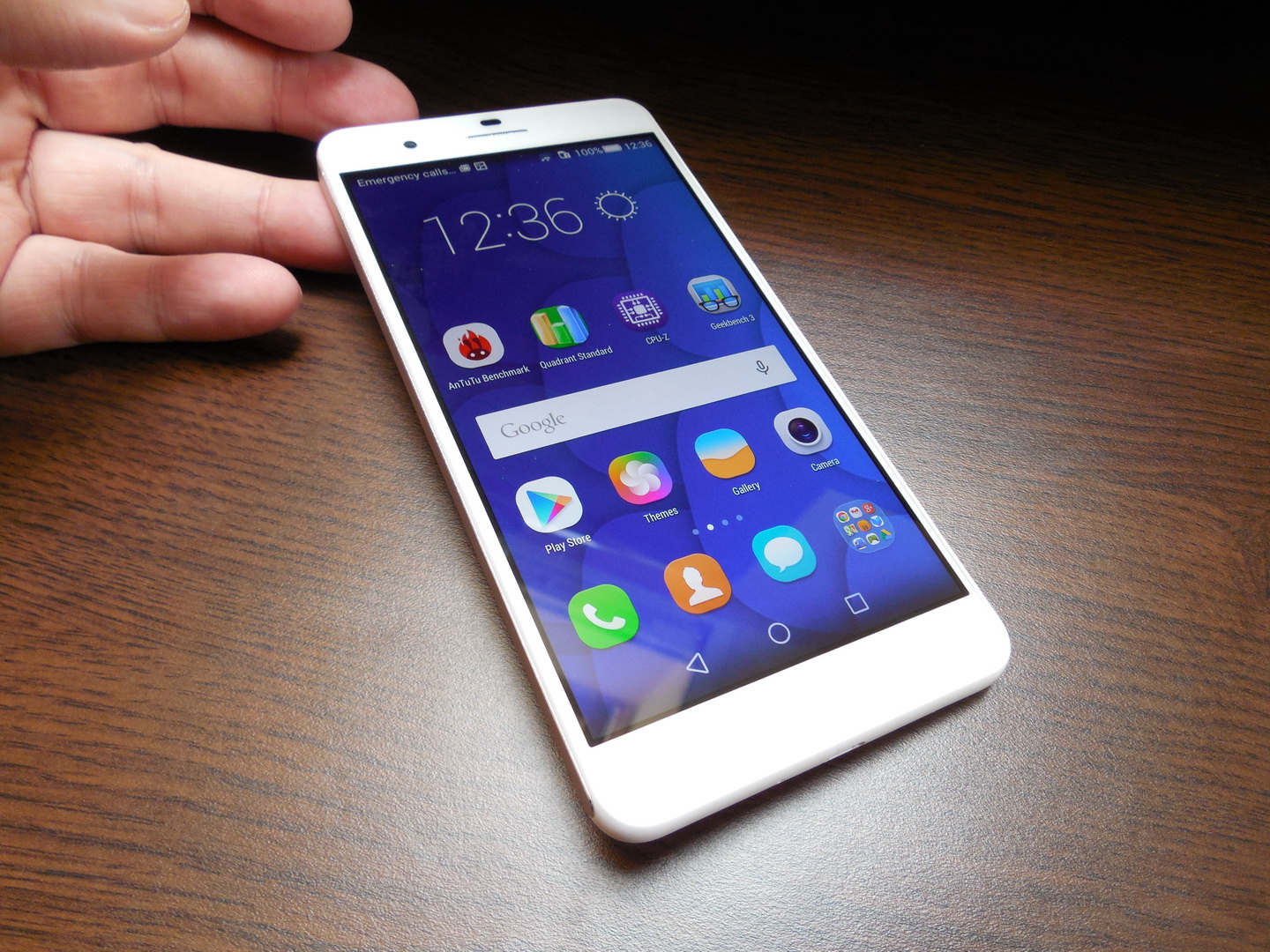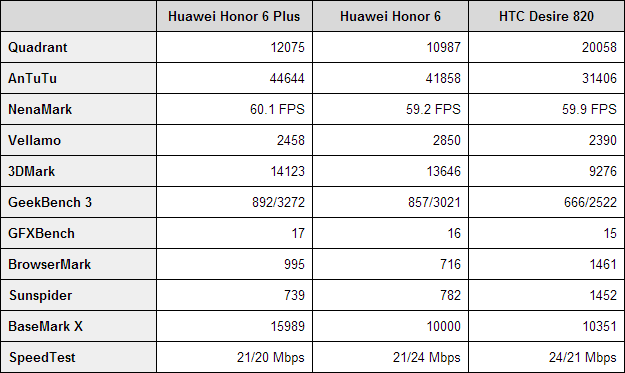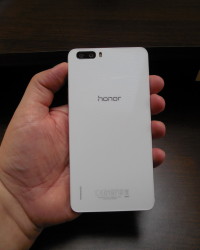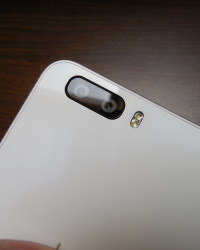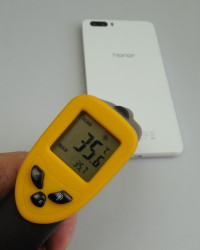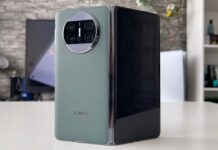It’s no wonder you’ll see an impressive number of food pics in the gallery taken with the Huawei Honor 6 Plus. This device seems to be made exactly for that purpose: taking pictures in restaurants, at concerts, events and vacations, so it’s ideal for bloggers. Now let’s see what this dual camera phablet is all about, in a full review below.
The device was launched in December 2014 and it’s basically a bigger Honor 6, a model we already reviewed. It stands out through a dual camera and dual SIM setup and it’s priced at $379 on Oppomart, which is pretty affordable. The device measures 7.5 mm in thickness and weighs 165 grams. It’s 7 grams lighter than the iPhone 6 Plus and 0.4 mm thicker.
It’s also 0.2 mm thinner than the Desire 820, one of its phablet rivals, plus 10 grams heavier than the same model. The form factor here is basic, rectangular, with rounded corners and with a front and back covered with glass. There’s a metal frame, shown at the top, left and right, while the bottom only has plastic. This model offers a solid feel and since it’s so big, one hand usage may be a problem.
At least, it doesn’t get fingerprints on its surfaces too easily and it’s not slippery, in spite of the glass. There’s no Huawei branding here, just the Honor brand at the back. Upfront we’ve got the sensors, earpiece, front camera and narrow plastic bezels (for the price segment), as well as a notification LED at the left of the camera.
The back features very small dots, with a 3D-like pattern and we find here the dual camera and dual flash, as well as the speaker. At the top there’s the audio jack and microphone, plus the infrared port. At the bottom there’s the microphone and microUSB port, while on the left there’s nothing. On the right we find the volume buttons and On/Off button, with good feedback.
There are dual slots here, one for the microSIM and one for the nano SIM, but it can also be used for the microSD. The design of this handset is quite good for an affordable and youthful phablet. The hardware includes an IPS LCD screen with a 5.5 inch diagonal and Full HD resolution, plus an octa core Huawei HiSilicon Kirin 925 processor, that includes 4 cores of the Cortex A7 kind, clocked at 1.3 GHz and 4 cores of the Cortex A15 kind, clocked at 1.8 GHz.
There’s also a Mali T628 GPU in the mix, 3 GB of RAM and 16 GB of storage, or 32 GB in the LTE version. The microSD card slot offers support for up to 128 GB and specs also include a dual 8 megapixel back camera and a front 8 MP shooter for selfies. On the connectivity front, there’s LTE, WiFi dual band, Bluetooth 4.0, GPS, Glonass, NFC, infrared, FM radio and microUSB 2.0.
We’ve also got DTS acoustics on board and the battery offered here is a Li-Po unit, with a 3600 mAh capacity. In our test, that involves HD video playback with WiFi on and brightness at 50% we achieved 9 hours and 12 minutes of playback, which is close to the Galaxy Note 3, that offered 9 hours and 30 minutes, so we’re doing fine. We also beat the Honor 6 and its 8 hours and 58 minutes.
Meanwhile, the iPhone 6 Plus scored 12 hours of playback, so that we didn’t beat. We also did a PCMark test, that simulates continuous usage, with brightness at 200 LUX. In this test, we achieved 3 hours and 58 minutes, which is not very much, especially since we fared lower than the disappointing Amazon Fire Phone and its 4 hours and 38 minutes, or the LG G Flex 2 and its 5 hours and 7 minutes.
The charging takes 1 hour and 54 minutes, which is not bad, beating the Galaxy A5 by 1 minute and the Honor 6 by 6 minutes. Of course, you can do better like the Oppo Find 7 does, with 1 hour and 20 minutes. I have to say that the charging time is OK and video playback is also good. Overall, you get one day of regular usage, maybe even one day and a half.
The Settings area includes Power Saving features, like Power Monitoring, that finds apps using too much power and makes recommendations about your usage. Power Saving features include Ultra, that only leaves basic features activated, like phone calling, texts and such and it triples battery life. There’s also Smart power saving, that auto adjusts the CPU and network usage.
Then there’s the Normal mode, that only makes small adjustments. Now let’s talk about acoustics. There’s a minimal audio player here, with a very basic interface. The handset doesn’t come with bundled headphones and its DTS feature can be set on or off, even without headphones, unlike the Huawei P8. The experience is reasonably loud and clear and the bass could be stronger, but the tunes with guitar are well heard. DTS makes the sound louder and more natural and it also adds extra treble.
The sound gets a bit muffled on a flat surface, though. We did a decibelmeter test and achieved 81.9 dbA at the front and 82.7 dBA at the back. We were close to the iPhone 6 Plus, that scored 83.8 dbA and close to the LG G Flex 2, that scored 82.9 dBA. We even beat the Huawei P8 and its 81.2 dBA, so overall acoustics are good. The display included here is a 5.5 inch unit, with Full HD resolution and IPS LCD panel. It’s protected by Gorilla Glass 3 and the video app also offers the DTS option.
The video experience is bright, we’ve got wide view angles and vivid colors, or better said oversaturated. There’s also OK contrast and a pretty crisp image. The pixels are of the RGB Stripe kind and the brightness we achieved in our luxmeter test was 432 LUX. This means we beat the HTC Desire 820 and its 396 LUX, the Honor 6 and its 383 LUX, as well as the HTC One M9 and its 362 LUX units.
The Settings allow us to tweak the color temperature, from warm to cold using a slider, as well as the font size and font style. Overall, this is a good display and now we finally move on to the selling point of the device, which is the dual 8 megapixel back camera, with dual LED flash. There’s also a front 8 MP camera here, for selfies.
The back cameras offer a system similar to the one of the HTC One M8, with one of them recording depth info. The UI of the camera is simple and minimal and filled with white text and white elements. At the left side we find the Portrait oriented settings, that include capture modes such as HDR, Watermark, Panorama, Best Photo, Beauty, Audio Note and Super Night.
Settings include resolution (13 MP – 4160 x 3120 in 4:3, 10 MP – 4160 x 2326 in 16:9), GPS Tag, mute, audio control, timer, touch to capture, capture smiles, object tracking, burst shot, volume buttons features and ISO (up to 1600). White balance, saturation and contrast, as well as brightness can be tweaked here. Then there’s the front camera shortcut and when that cam is triggered, you can use a Beauty Slider, brightness control options and you can also do Full HD video capture with the front cam.
On the right side of the UI we find the shutter button, video capture, effects and wide aperture mode. Video capture is done in Full HD, 16:9 and with stereo audio. There’s digital stabilization in the mix and a Beauty Mode, too, plus Object Tracking. Wide Aperture is the most interesting mode, since it’s ideal for capture of objects placed at up to 2 meters in distance.
You can play with aperture from F/0.95 to F/16. The default offered by the camera is F/4.0. Now let me explain to you what the aperture thing is all about. A larger aperture means more light enters the lens and a large aperture means a small number. A large aperture capture means the shot isolates foreground from background. The small aperture means everything is in focus.
The actual camera experience involves a fast focus, but not very fast capture. Zoom is fluid and there’s an exposure slider included here in the mix, sort of like the one on iOS. If you keep the screen pressed, you can change the metering and focus by moving around two round icons. Now let’s discuss the gallery included here. It abounds with burgers and icecream, so beware if you haven’t eaten yet today!
The shots (gallery here) were taken on a cloudy day and then a sunny one. We’ve got excellent closeups of icecream and excellent level of detail. The texture is perfect, colors are realistic and focus was great. You can adjust the aperture even post capture and play with the focus however you want thanks to the two cameras. The details are great when zooming in, especially onto that green purse.
The HDR we did was bright and it highlighted nice details, but it also changed the color of the shot to a less realistic one. The panorama was wide and offered a resolution of 10.000 x 1643 pixels. The landscape shots looked great and it was basically impossible to take a blurry shot with these cameras. Macros were simply perfect, no matter what color the flowers or burgers were.
In spite of the sunnier moments, the flowers weren’t burnt and the colors were realistic. Selfies were a bit too white-ish and the face texture felt too smooth, even without beauty effects applied. During the zoom test of that clock we found the details to be pretty impressive even at 2/3 zoom. Food and roses we shot on the very sunny day handled light perfectly and while they may have seemed slightly burnt, the effect wasn’t that bad in the end.
Exposure, white balance and clarity were top notch here. Pictures are overall excellent with the Huawei Honor 6 Plus, which I would even dare to compare to the iPhone 6 quality-wise. At night we registered good colors, even without the flash on and a good handling of street lights and light sources. The pics got a bit blurry when the flash was lacking and Super Night was once again amazing, like on the Huawei P8. It made the night into day.
Video capture happened in MP4 format, in Full HD, at 29 FPS and with a big bitrate of 24 Mbps. The first video was crisp, clear, had good acoustics and good colors, plus a good focus and a so-so stabilization. The second video managed to handle the noise OK and many moving subjects with no problem, but there was also a violent exposure change.
The third video had great focus, OK zoom quality and no focus loss. Fourth video felt like a filter was applied, but it was in fact the golden hour of a sunny day. Exposure was strange, but the colors and quality were good. I’d say this phablet’s cameras can hold their own in front of the HTC One M8, even the M9 and also totally beat the HTC Desire 820.
You can also do a bit of editing, with options like Rotate, Filters, adjust, crop, beauty, contrast, saturation and hue. We played around with the phone, using the title Riptide GP2 for 15 minutes and reached a temperature as high as 35.7 degrees Celsius, so there’s no overheating here. The web browser is fast and we’ve got a comfy virtual keyboard shown on the screen, while Swype is also offered here.
The telephony part involves a clean and crisp experience, OK signal, but the volume is not very high. WiFi also drops sometimes. Now let’s talk benchmarks! We compared the Huawei Honor 6 Plus with the Honor 6 and HTC Desire 820. The battle is done between the HiSilicon Kirin 925 octa core unit with an octa core Hisilicon Kirin 920 and an octa core Snapdragon 615.
These are the results:
Overall, we won 7 out of 11 battles and this model has no lag, plus it runs Riptide GP2 and 3D games like a charm. The OS here is Android 4.4.2, with Emotion UI 3.0, that feels like at home if you’ve seen a Honor 6 in action. There are slim fonts here, elegant icons and white text and circular UI portions. The interface is minimal if you pinch the screen, you will trigger the wallpaper, widget, transition and Home Settings area.
There’s no app drawer here and all apps are placed on the homescreens. Multitasking is shown as 4 thumbnails on the screen, in a system similar to HTC’s Sense. Swipe up and they’re gone. If you swipe down in the homescreen, you will be able to trigger a search bar. The notification dropdown portion is shown as a timeline, with the time next to each event.
The Quick Settings area offers a Do Not Disturb and Screenshot option, plus connectivity options. In the Settings area we find the Home Screen Style, Touch Plus, Motion Control, Nav Bar options and More. The latter includes One Hand Usage, Suspend Button, Touch Disable and Gloves. The lockscreen offers a few shortcuts like calculator, torch, camera and share, with a swipe up.
The preinstalled apps list includes Themes, Google apps, Phone Manager, Calendar, Files, HiCare, Smart Controller (TV remote feature), Weather, Mirror, Magnifier, Torch, Notepad, Rec, Backup, Updated, Kingsoft Office, Magic Tag, Twitter and games. There’s a bit of bloatware here and overall the UI is fluid. Now let’s see the verdict!
These are the Pros:
- no fingerprints left on glass
- great camera
- nice design
- OK video playback time
- good speaker
- bright screen
- great aperture options
- no lag
And the Cons:
- poor continuous usage
- selfies could be better
- bloatware on board
- big price in some stores
- video exposure
Huawei Honor 6 Plus gets a 9.2 out of 10 for design from us, a 9.3 out of 10 for hardware and a 9.6 out of 10 for OS and UI. The final grade is 9.36 out of 10 and this is a great blogger phone and food blogger phone especially. It runs games perfectly, has a bright screen and performs great macros. There’s no big flaw here, so let’s go ahead and round up the grade to 9.4 out of 10.

